MATH 304 -- Ordinary Differential Equations
Solutions -- Lab 3
November 6, 2000
A)
> aux:=2*10^(-6)*r^2+10^(-3)*r+1;
![]()
> fsolve(aux,r,complex);
![]()
> v1:=t->exp(-250*t)*cos(661.4378278*t);
![]()
> v2:=t->exp(-250*t)*sin(661.4378278*t);
![]()
> vp:=t->A*cos(50*t)+B*sin(50*t);
![]()
> 2.0*10^(-6)*diff(vp(t),t$2)+1.0*10^(-3)*diff(vp(t),t)+vp(t);
![]()
> ABsol:=fsolve({.995*A+.05*B,-.05*A+.995*B-20},{A,B});
![]()
> vpp:=t->subs(ABsol,vp(t));
![]()
> vC:=t->c1*v1(t)+c2*v2(t)+vpp(t);
![]()
> vC(t);
![]()
> initeqs:={vC(0)=0,subs(t=0,diff(vC(t),t))=1};
![]()
![]()
> cvals:=fsolve(initeqs,{c1,c2});
![]()
The transient terms die away to zero very quickly in this example:
> plot(10*v1(t)+20*v2(t),t=0..0.1);
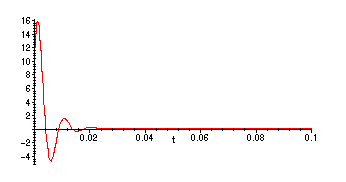
> plot(subs(cvals,vC(t)),t=0..1);
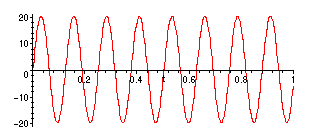
B)
The case R = 0
If
![]() is not a root of the auxiliary equation, the general solution is:
is not a root of the auxiliary equation, the general solution is:
> vnonres:=t -> c1*cos(t/sqrt(L*C))+c2*sin(t/sqrt(L*C))+a/(1-omega^2*L*C)*sin(omega*t);
![[Maple Math]](images/Lab317.gif)
If
![]() is a root of the auxiliary equation, then the general solution is
is a root of the auxiliary equation, then the general solution is
> vres:=t->c1*cos(t/sqrt(L*C))+c2*sin(t/sqrt(L*C))-a/(2*sqrt(L*C))*t*cos(omega*t);
![]()
C)
For the first two cases here,
![]() and
and
![]() ,
,
![]() is not a root of the auxiliary equation, so we use the first form from question B:
is not a root of the auxiliary equation, so we use the first form from question B:
> C:=1.0*10^(-6); L:=1; a:=1;
![]()
![]()
![]()
> vres(t);
![]()
> vnonres(t);
![[Maple Math]](images/Lab327.gif)
> omega:=900;
![]()
> initeqs1:={vnonres(0)=1,subs(t=0,diff(vnonres(t),t))=0};
![]()
> sol1:=fsolve(initeqs1,{c1,c2});
![]()
> plot(subs(sol1,vnonres(t)),t=0..0.1);
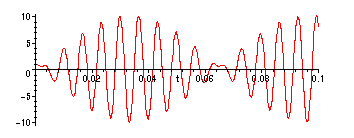
>
> omega:=950;
![]()
> initeqs2:={vnonres(0)=1,subs(t=0,diff(vnonres(t),t))=0};
![]()
> sol2:=fsolve(initeqs2,{c1,c2});
![]()
> plot(subs(sol2,vnonres(t)),t=0..0.1);

![]() does give
does give
![]() a root of the auxiliary equation so we need to
a root of the auxiliary equation so we need to
use the second form of solution from question B
> omega:=1000;
![]()
> initeqs3:={vres(0)=1,subs(t=0,diff(vres(t),t))=0};
![]()
> sol3:=fsolve(initeqs3,{c1,c2});
![]()
> plot(subs(sol3,vres(t)),t=0..0.2);
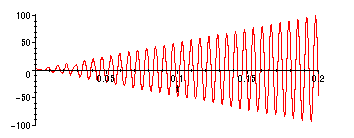
This is the resonant solution -- the amplitude of the oscillations is increasing without
bound as t increases.
The final two cases are like the first two:
> omega:=1050;
![]()
> initeqs4:={vnonres(0)=1,subs(t=0,diff(vnonres(t),t))=0};
![]()
> sol4:=fsolve(initeqs4,{c1,c2});
![]()
> plot(subs(sol4,vnonres(t)),t=0..0.1);
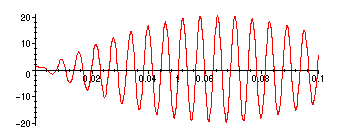
>
> omega:=1100;
![]()
> initeqs5:={vnonres(0)=1,subs(t=0,diff(vnonres(t),t))=0};
![]()
> sol5:=fsolve(initeqs5,{c1,c2});
![]()
> plot(subs(sol5,vnonres(t)),t=0..0.1);
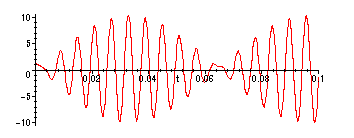
D) If R > 0, then roots of the auxiliary equation are
r =
![[Maple Math]](images/Lab350.gif)
r =
![[Maple Math]](images/Lab351.gif)
The real part is always negative in both, so all solutions tend to zero as
![]() .
.
Get real solutions only if
![]()
E)
> R:=2000.; C:=2.0*10^(-7); L := 1.5; omega:='omega';
![]()
![]()
![]()
![]()
> aux:=L*C*r^2+R*C*r+1;
![]()
> fsolve(aux,r,complex);
![]()
> v1:=t->exp(-666.6666667*t)*cos(1699.673171*t);
![]()
> v2:=t->exp(-666.6666667*t)*sin(1699.673171*t);
![]()
Again, the transients (the homogeneous solution terms) will die away so quickly that the
particular solution determines the shape for large t. The particular solution in this
case always has the form
![]() since neither of these
since neither of these
terms solves the homogeneous equation if R is not zero (all solutions of the homogeneous
equation contain a decaying exponential by question D).
> vp:=t->A*sin(omega*t)+B*cos(omega*t);
![]()
> ss:=L*C*diff(vp(t),t$2)+R*C*diff(vp(t),t)+vp(t);
![]()
![]()
> a:='a';
![]()
> collect(ss,{cos(omega*t),sin(omega*t)});
![]()
![]()
> ABsol:=solve({-.3000000000e-6*B*omega^2+.4000000000e-3*A*omega+B,-.3000000000e-6*A*omega^2-.4000000000e-3*B*omega+A=a},{A,B});
![[Maple Math]](images/Lab369.gif)
![[Maple Math]](images/Lab370.gif)
> vpp:=t->subs(ABsol,vp(t));
![]()
The long-term behavior is determined by the particular solution, so as a
"short-cut" we only plot that (!!!!!!)
For
![]() different from the frequency of the homogenous solution, the particular
different from the frequency of the homogenous solution, the particular
solutions will look like a sinusoid with amplitude roughly
a,
frequency
![]()
> omega:=100; a:=10;
![]()
![]()
> plot(vpp(t),t=0..1);
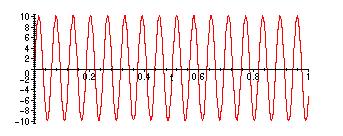
If
![]() or so (the frequency of the homogenous solutions), then something interesting happens:
or so (the frequency of the homogenous solutions), then something interesting happens:
> omega:=1699.67; a;
![]()
![]()
> plot(vpp(t),t=0..0.1);
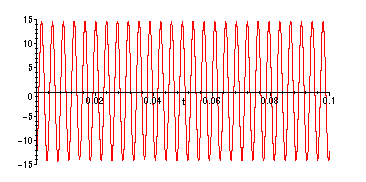
Note that the amplitude here is significantly larger than the amplitude of the forcing term:
![]() .
.
If
![]() , larger than the frequency of the homogeneous solutions, then something else happens:
, larger than the frequency of the homogeneous solutions, then something else happens:
> omega:=3000: plot(vpp(t),t=0..0.01);
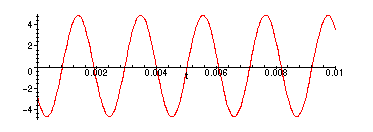
Here the amplitude is much smaller than 10; the frequency is also much larger, so we have
plotted a smaller piece of the solution.
In fact, we can plot the amplitude of the particular solution as a function of the forcing frequency
![]() , as follows. The particular solution is
, as follows. The particular solution is
> vpp(t);
![[Maple Math]](images/Lab385.gif)
![[Maple Math]](images/Lab386.gif)
which has the form AA cos(
![]() ) + BB sin(
) + BB sin(
![]() ). Every such function is a sinusoid,
). Every such function is a sinusoid,
with amplitude
![[Maple Math]](images/Lab389.gif)
> AA:=coeff(vpp(t),sin(omega*t)):
> BB:=coeff(vpp(t),cos(omega*t)):
To plot, we take a = 1:
> a:=1;
![]()
> amp:=simplify(sqrt(AA^2+BB^2));
![[Maple Math]](images/Lab391.gif)
> plot(amp(omega),omega=0..5000);
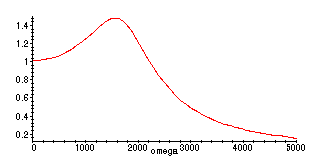
There is resonance in the sense that the amplitude of the longterm solution can be larger
than the amplitude of the forcing term, but the solution is always bounded, unlike the R = 0 case.